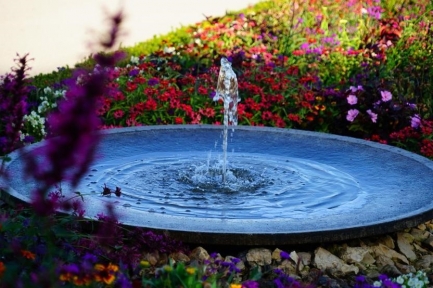 By Pat Woodard
By Pat WoodardPhoto: Lawnstarter (Source)
July 28, 2022 (San Diego’s East County) – “Water, water everywhere, nor any drop to drink.” When Samuel Taylor Coleridge put that line into his Rime of the Ancient Mariner in 1798, he left out lawn watering. Being from Soggy Old England, having enough water for a proper garden or lawn wasn’t a priority for the author.
Still, his suggestion of being surrounded by something you can’t use fits San Diego when it comes to water use. The salty waters of the Pacific Ocean may be limitless, but they’re not so great for household use. That’s why San Diego buys fresh water from Northern California and the Colorado River. As water needs increase with the population, it’s clear San Diego needs to find ways to get the most from every drop.
 Efficient Watering
Efficient WateringPhoto, right: Brenda Ryan / LawnStarter
It’s not just how much you water that counts; it’s how well you water. That’s true whether you’re watering a lawn or a backyard garden. Efficiency is a key to water use anywhere, but it’s especially critical in an area with a climate that includes arid desert influences.
An automatic watering system saves water, time, and money, especially if it’s programmed to come on when it can do the most good. “Cycle and soak” irrigation provides water in multiple, brief cycles, providing more water to your lawn’s roots by preventing runoff.
Instead of watering a zone for 15 minutes, set the sprinklers to run three times for 5 minutes, with 30 minutes of soaking time between cycles. You’ll waste less water, and your lawn will be healthier.
 Less is More
Less is MorePhoto, left: Brenda Ryan / LawnStarter
You can make your lawn a lot more water-wise by creating a space that requires less water, while still showing off a carpet of grass. Hardscaping incorporates solid elements into landscapes; things like rocks, retaining walls, paver patios, walkways, and the like. It can be just about anything that’s not plant life, and thus needs no water.
By blending hard elements with your grass lawn, you reduce the size of your watering footprint and make your lawn more visually interesting. You can even reduce fire danger by having less combustible plant material to feed a wildfire.
 Go Native
Go NativePhoto, right: Cultivar 413 on Flicker (Source)
Before people started putting in grass lawns that seem to have an unquenchable thirst, it’s not as if San Diego was an expanse of bare dirt. Native plants and flowers did just fine without irrigation systems and people to nurture them. Adapted to both the local soil and climate, they were heat tolerant and drought resistant. They still are.
Succulents like cacti and agave are designed to protect themselves against hot weather and even fire. San Diego sunflowers tolerate dry weather and bloom most of the year. California fuchsia is easy to grow and attracts hummingbirds. Cultivating native plants is a great way to be more water-friendly at home and comes with the side benefit of being low maintenance.
 Water Wise
Water WisePhoto, left: Brenda Ryan / LawnStarter
The average Californian uses 85 gallons of water per day at home, most of it outdoors. With California in the grip of a persistent drought, the city of San Diego has implemented stricter water restrictions that will be in place until at least June of 2023. That means limits on lawn watering, and even a ban on car washing at home.
That’s just part of the strategy to create a more water-friendly community. San Diego also has a variety of incentives to help people save water; rebates for replacing turf, installing irrigation systems, and collecting water that falls from the sky into an old-fashioned rain barrel. As water consciousness grows in San Diego, new habits can help a community become both water-friendly, and water wise.
 Pat Woodard is a freelance writer who takes occasional breaks from high country hikes to chase golf balls, rainbow trout and full-bodied red wines. He's also a longtime radio and television broadcaster, documentary producer and runner-up on “Jeopardy.”
Pat Woodard is a freelance writer who takes occasional breaks from high country hikes to chase golf balls, rainbow trout and full-bodied red wines. He's also a longtime radio and television broadcaster, documentary producer and runner-up on “Jeopardy.”






Recent comments